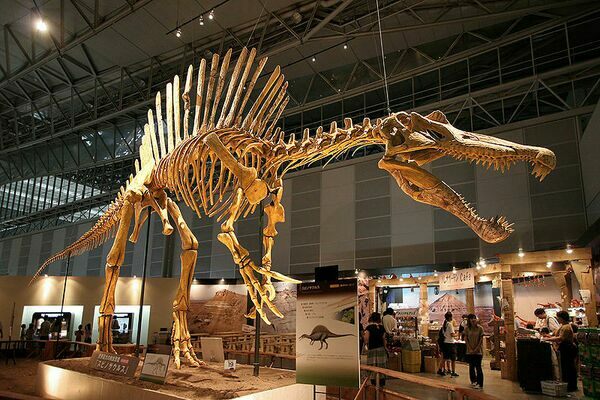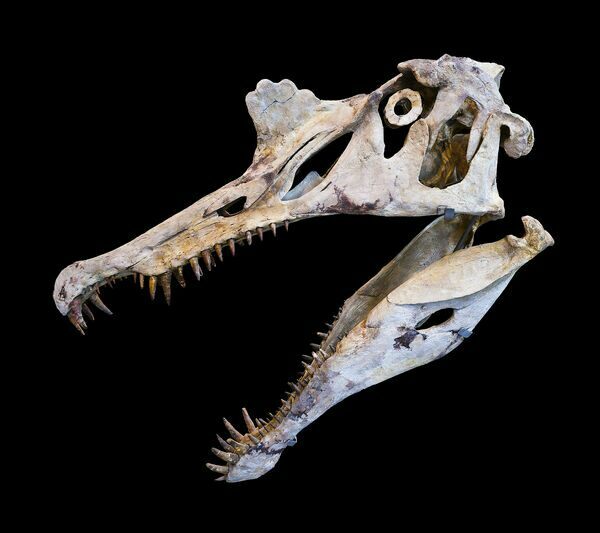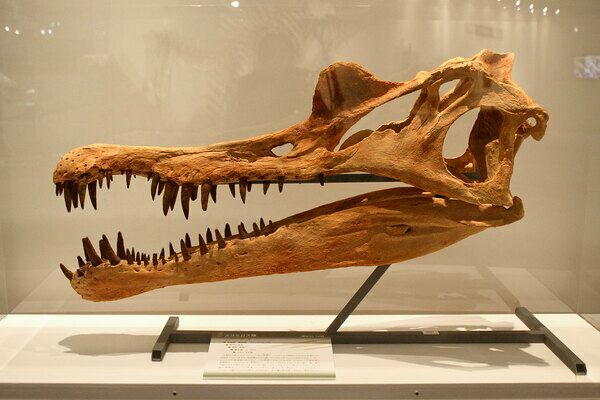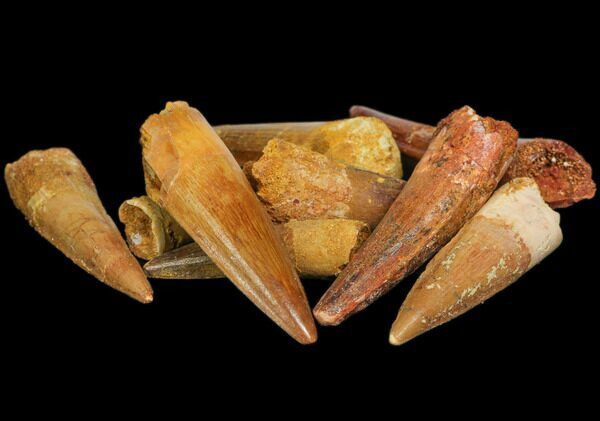SPINOSAURUS TEETH FOR SALE
About Spinosaurus
Spinosaurus is the largest known theropod dinosaur, and lived between 99 to 93.5 million years ago in the Late Cretaceous period. The exact size of this prehistoric behemoth is under debate but recent finds and studies have suggested that it reached lengths of 50 feet and weighed as much as 20 tons. It had an unusual appearance, and is famous for the long, distinctive spines along its back.
Spinosaurus was piscivorous, eating almost exclusively fish, but it likely scavenged and fed on whatever it could find, including other dinosaurs. Recent discoveries indicate that is was probably semi-aquatic, not just hunting fish from the warm shores of the Cretaceous lakes, rivers, and tidal flats of north Africa, but also swimming and diving for its prey.
Quick Facts
Spinosaurus Description
Spinosaurus fossils are primarily found in Morocco and Egypt. In Egypt, they are found in the Bahariya Formation. In Morocco, they are found in the Kem Kem Beds. They lived during the Cenomanian stage of the Late Cretaceous, specifically spanning 97 to 93.5 million years ago. Baryonyx, found in England, and Suchomimus, found in Niger, are two species with crocodile-like skulls that are often referred to for comparisons with Spinosaurus.
The neural spines, which were extensions of the vertebrae, grew to at least 5.4 feet long (1.65 m). They were 10 times longer than the diameters of the vertebrae they extended from. Their shape is distinctive from other described fauna. Both the fin-backed Edaphosaurus that lived from the late Carboniferous through the early Permian and the mammal-like Dimetrodon from the Permian had similar spines. Both had thin, rod-like spines that reached to the sky. Spines of the three-toed, herbivorous iguanodont Ouranosaurus were thicker than Spinosaurus.
The differences in the spine shapes between Spinosaurus and these very distinct animals suggest that Spinosaurus structures may have had a different purpose. However, Ouranosaurus lived a few million years before Spinosaurus in corresponding habitats: this supports a possibility of parallel evolution, hinting that species may have had different but similar structures that served the same ultimate purpose in the wetlands and aquatic environments of what is now northern Africa.
While likely to have had skin between the extensions on the vertebrae like the sail-backed synapsids, some scientists argue that the spines of Spinosaurus are thicker, relatively shorter, and must have a different function. Supporters posit that these features are similar in purpose and design to those of hump backed mammals. In mammals, comparable bony structures can lend internal support to fat and tissue. Fat storage would be useful to survive seasonal fluctuations of prey availability- such as spawning or migration.
The tissue and spines may have evolved for thermoregulation. Some scientists suggest that a membrane or tissue extended between the spines to assist with warming or cooling the body. Considering a buffalo-hump theory, insulating fat could have been useful in regulating body temperature while immersed in water and added to the overall weight helping it stay submerged. Other scientists suggest that the spines supported skin which made the giant dinosaur appear larger or that some kind of pattern on the skin helped to identify individuals.
Spinosaurus Size
While Spinosaurus teeth are quite common, skeletal fossils and in particular articulated material are very rare. Due to the limited skeletal evidence, its exact size is up for debate. Some of the most recent studies have placed its maximum size in the range to 41-50 feet long, though more controversial estimates have suggested a maximum length approaching 60 feet. With the huge spines along its back Spinosaurus may have stood nearly 20 feet tall: this would easily make it the largest theropod dinosaur known. For comparison, the largest known T. rex was about 42 feet long.
Estimating the weight of Spinosaurus is even more error prone. Most estimates put its maximum weight between 8 and 12 tons, but estimates as high as 20 tons have been made based on more recently discovered skeletal fossils. This would decidedly outweigh the largest T. rex at 7.5 tons. These beasts were extremely hefty, appeared even larger than their actual tonnage, and their definitive size is still contested. Regardless, it is a truly massive dinosaur!
Specialization Of Skull And Teeth
The massive, nearly 6 foot skull of Spinosaurus is narrow like that of a modern crocodilian. Spinosaurus fossil remnants are indicative of a semi-aquatic piscivore. It had evolved lengthened jaws with conical, unserrated teeth and raised nostrils. The semi-aquatic hypothesis is supported by isotope analysis on teeth and a diet that included fish and land animals. Its secondary palate allowed it to eat and breathe at the same time. Crocodiles share this trait. Spinosaurus also share a unique piscivore trait: their skulls have less resistance to torque (rotational forces) when compared to obligate terrestrial predators.
Overall, Spinosaurus grins look quite crocodilian. The robust front upper jaw possess 6-7 teeth protruding from both sides of a narrow snout. 12 large teeth are located on either side, behind those of the premaxillae. Of the teeth at the front of the snout, the largest, second, and third have a distinctive space behind them. This created a place in the bite for the large lower teeth.
Weathered or broken fossil teeth are fairly common. Large, well-preserved teeth over 3 inches long are rare finds. Fake teeth can be created by gluing together pieces of smaller teeth and hiding the evidence with painted enamel and rings of sand around the glued joints. Restoration is not uncommon with dinosaur fossils. Honest professionals who carefully inspect fossils with the proper tools can identify the level of reconstruction.
Spinosaurus Lifestyle & Behavior
Spinosaurus lived among predatory giants of the Cretaceous. Its life history is constructed by examining the fossilized contents of its meals, and other fauna of its north African environment. Analogs have been studied that the dinosaur lived on the westward drifting South America, as well.
Spinosaurus hunted among species of confounding size such as Carcharodontosaurus and titanosaur sauropods. Spinosaurus may have defended itself from the 33-foot long crocodylomorph Stomatosuchus and the even longer Sarcosuchus: Sarcosuchus was a 40 foot long, 10 ton crocodile that shared its aquatic habitat with Spinosaurus. Scientists assert that Spinosaurus occupied its niche in response to the other large predators in its environment- possibly altering its hunting area or diet preferences depending on shifting competitive pressures.
While commonly thought of as a resident of modern Egypt, Morocco, and Tunisia, the contents of its stomach have been analyzed from specimens of related European and South American taxa, as well as from scale imprints found in the type specimen. These studies support the non-obligate piscivore lifestyle, which included possible scavenging on land and a prey size that was selected relative to the size of the Spinosaurus individual.
An insightful study in 2009 by Dal Sasso et al. revealed the possibility that pressure receptors were located in a cavity on the inside of the snout. Within this space, the receptors may have detected the communication of foramina that respond to movement in the water. In this manner, Spinosaurus would have been able to detect unseen prey. This hypothesis was developed from the results of x-ray tomography and is cited from the 1st International Congress on North African Vertebrate Palaeontology.
Spinosaurid gait likely differed from other land-dwelling quadrupeds. It likely walked primarily on its back legs, with some kind of occasional crouching posture. However, the discovery of Baronyx challenged this hypothesis with its thicker, stronger forelimbs. The mass of the spinosaurid hump, depending on the tissue it supported, would have been significant. Now, scientists assert that Spinosaurus could have used its forelimbs like that of a quadruped when it was inclined to do so. Theropods including Spinosaurus could not rotate their forearm and face their palms downward. Theropod prints of the Early Jurassic show that they could support some weight on the sides of their hands. Spinosaurus could have used this posture as well.
Spinosaurus Reproduction & Eggs
Though no Spinosaurus eggs have ever been found, the eggs are supposed to have been birdlike, and about the size of a mango. Like other large theropods, Spinosaurus was too heavy to lay on its eggs. Scientists suggest that they probably covered the nest with plant material.
Environment & Habitat
The gradual breakup of supercontinent Pangaea occurred throughout the Jurassic, and many continents were recognizable and separate by the Cretaceous. In the early Jurassic, Africa and South America lingered as one land mass. As the Jurassic progressed, North America separated from Africa across a narrow seaway to the north. This seaway opened up to become the Atlantic Ocean.
When Spinosaurus lived in the Cretaceous, the African coast was largely equatorial, and the climate was hot and humid. An enormous, rather shallow sea covered the modern northeastern region around Egypt around 94 million years ago, perfectly suited to Spinosaurus. Its coastlines, tidal flats, and channels of fish would have been lined with mangrove forests. Large predators competed for food and seasonal changes may have influenced diet. A tooth found in a South American pterosaur suggests that in the dry season spinosaurids might have resorted to eating pterosaurs.
By the Cretaceous, Africa and South America were separated from each other by the South Atlantic Ocean. This is relevant to piecing together aspects of the Spinosaurus life history by studying closely related species in South America. Other land masses were separated by seas, such as a long band of ancestral Rocky Mountains, Australia and Antarctica, the Midwest and east coast of North America, and the giant landmass of Eurasia: Spinosaurus is unlikely to be found in these areas.
Extinction
Spinosaurus's extinction played out through a different set of events than what killed the rest of the dinosaurs 65 million years ago. As its environment dried up during a change in climate, dwindling habitat would have reduced prey and increased competitive pressures among other large predators. Spinosaurus may have been too specialized for an aquatic habitat: losing this kind of habitat would have devastated its population even with a diet that didn’t consist solely of fish.
How Big Are Spinosaurus Teeth?
When talking about dinosaur tooth size it is very important to distinguish whether you are measuring just the crown of the tooth or also including the root of the tooth. he root of a Spinosaurus tooth may be 2 or 3 times as long as the crown. Some people include the root when comparing tooth sizes, while others just compare crown sizes.
The very largest Spinosaurus teeth have crowns of around 5 inches long but may exceed 12 inches in length if the full root is present (very rare). The vast majority of teeth are much smaller, ranging between 1 to 3 inches in length. The reason for this is that dinosaurs shed their teeth while growing, so you will end up with many more teeth of juveniles or sub-adults than fully-grown spinosaurs.
Nice teeth over 3 inches in length are difficult to find on the market, particularly ones that are in good condition. Not only are these larger teeth rarer in the fossil record, but they are much more likely than the small tooth to have been broken or to have sustained significant damage. Most larger Spinosaurus teeth for sale have been repaired, are heavily restored, or are composites of multiple partial teeth.
We have acquired and sold well over ten thousand Spinosaurus teeth over the years. The sizes roughly break down as follows:
Where Are Spinosaurus Teeth Found?
Spinosaurus teeth are collected from the Kem Kem Beds, a geological group along the Algeria–Morocco border in the Kem Kem region of eastern Morocco. The majority of the fossil teeth are found in a thin bed that outcrops the edge of a large plateau near Taouz. The layer represents a river delta where teeth and other small fossils were concentrated by the river. While teeth are common, larger intact bones or articulated material is quite rare since they were broken up by the river prior to fossilization.
Local miners collect fossils from these by hand-digging narrow tunnels into the plateau following the productive layer. Some of the local villages derive the majority of their income through the collection and sale of these teeth.
A paper on the assemblage of the Kem Kem Beds can be found at: Vertebrate assemblages from the early Late Cretaceous of southeastern Morocco: An overview
Why Are Spinosaurus Teeth So Inexpensive?
Smaller Spinosaurus teeth are fairly inexpensive because they are fairly common in the Kem Kem Beds of Morocco, and there are lots of people digging for them. Research indicates that Spinosaurus was a very abundant dinosaur in the river deltas of what is now southern Morocco and that they shed their teeth pretty frequently like sharks do. Once teeth reach 3 inches long, they start to become exponentially more rare: evidently most individuals didn't live long enough to reach full size and most teeth shedding was done as the dinosaurs reached maturity.
A Note On Composited And Heavily Restored Spinosaurus Teeth
Spinosaurus teeth buyers need to be on the lookout for composited and heavily restored teeth. The vast majority of teeth, particularly larger teeth, are fractured while in the earth and come out of the ground in pieces. These teeth are typically repaired by gluing them back together. Most Spinosaurus teeth (and dinosaur fossils in general) will have repairs and this repair work typically doesn’t have much of an impact on valuation and price.
A lot of the commercially available Spinosaurus teeth and again most of the large ones have been restored (missing areas are reconstructed), or composited (two or more partial teeth are attached together to make a full one). Restoration and compositing does have a very significant effect on the price of a tooth. A composite tooth will typically sell for a fraction of the price of an unrestored one.
For some people that just want a cheap dinosaur tooth this restoration/compositing may not matter, but it matters a lot for collectors who will pay a premium unrestored tooth. Disclosure is key. While we do sell repaired/restored/composited teeth in addition to totally intact ones, we are careful to disclose this fact in the individual listings and the specimens are priced accordingly.
How Many Teeth Did A Spinosaurus Have?
Spinosaurus had roughly 38 teeth in its upper jaw alone. The forward section on each side had between six and seven larger teeth, followed by an additional twelve smaller teeth behind them. At the front of the snout, several large, interlocking, slanted teeth assisted in snagging prey as it swam past. Despite their rather powerful jaws, the lack of serration and shape of each tooth leads to the conclusion that Spinosaurus primarily fed on fish.
Why Is The Interior Of Many Spinosaurus Teeth Ivory White? Does That Mean They Are Fake?
When a Spinosaurus tooth is broken, the interior of the tooth will appear to be a brilliant ivory white. This is because the interior is composed of a phosphate-based mineral that is reactive to oxygen. After it's been exposed to air for some time, it will change from a bright white to a more yellowish color. A bright white interior is not a sign of a composite but rather a freshly broken tooth.
News: High Concentrations Of Spinosaurus Teeth Support Theory Of Aquatic Lifestyle For Spinosaurus
The debate over whether Spinosaurus enjoyed a semi-aquatic vs mostly-aquatic lifestyle simmered over the past decade. Several studies have analyzed adaptations of the dinosaur which seem to point to an aquatic lifestyle. These include eyes located toward the top of the skull, a long tail optimal for water propulsion, hind limbs designed for swimming, and a bone density similar to modern aquatic mammals.
A study published in September 2020 analyzing a sample of over 1,200 fossils from the Ifezouane Formation (Lower Portion of Kem Kem Beds) found that 45% of the total fossils were Spinosaurus teeth. Less than 1% of the fossils came from terrestrial dinosaurs and Spinosaurus teeth even vastly outnumbered fossils from other known aquatic species such as sawfish.
According to David Martill, a co-author of the paper, the "enhanced abundance of Spinosaurus teeth, relative to other dinosaurs, is a reflection of their aquatic lifestyle. An animal living much of its life in water is much more likely to contribute teeth to the river deposit than those dinosaurs that perhaps only visited the river for drinking and feeding along its banks".
 Reviews
Reviews
























